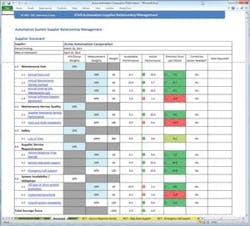With leaner engineering departments and changing technologies to choose from, selecting the right solution is an ever-growing challenge. So the question becomes, "What's the best process for making a strategic selection." The follow-up is "How can we manage our supplier performance to achieve optimum long-term results."
First you need to understand that selecting the right technology will require both research and a team effort. You need to clearly define the scope of the project. Have you had a past solution, and why are you considering a change? What are the key benefits you're seeking? Do you want to improve quality? Agility? Performance? Reduce costs? What are the attributes that will make your company more competitive? After all, isn't that the ultimate question?
Selecting the right supplier will require the development of an extensive criteria list. A highly technical solution will typically have over 150 criteria to evaluate. These will fall into one of three categories:
- Capabilities – In this category, you are evaluating the current capabilities of the company and its products or services. Are they features you need, and can this company provide them? Does the company have technical support in your region? Is there a local training department? Are parts stored locally.
- Presence – In this category, you are evaluating the current stability, growth and penetration of the supplier and its products or services in your context (region and/or industry). Is the company a relevant supplier of this technology or service? Is it successful in my industry? In my region? Is it growing?
- Vision – In this category, you are evaluating the alignment of the company with your corporate goals and future vision. Is the candidate company developing technology that you will be using in the future? Is it investing in this technology? Is it supporting future standards? Is it staffing as you want it to to provide the kind of support you will need?
Your evaluation criteria should be straightforward, easily understandable and, ideally, drive a quantitative response. Make sure your question facilitates a scalable result. For example, a question about support personnel could be, "Do you have support personnel in my region?" However, a better question would be "List the support personnel you have in my region and give their history." Creating criteria that prompt yes/no responses do little to help compare one solution to another.
Think as broadly as possible about your selection criteria. Don't forget to include categories for integration with other business systems, long-term ownership and career planning (How will ownership transition to new stakeholders as careers advance? How will new users be brought up to speed?). Don't forget to consider items you will encounter over the life of a system; e.g., upcoming technologies, standards or enhancements to your business practices.
Once you've made your selection and implemented the system, you'll need to move on to supplier performance relationship management (SPRM), and focus on maximizing the benefits of this selection over the lifecycle of the solution.
It is a fact that for strategic and complex technology solutions, the total cost of ownership over the lifecycle of the product is over four times the initial cost of acquisition and implementation. You have service costs, technology upgrades, spare or replacement parts, training, consulting and continued engineering. These are all important categories to consider in making the initial selection, but they are also important areas to manage on an ongoing basis to maximize the benefits of the system and the value derived through your relationship with the supplier.
Figure 1.Quantifiable goals, checked regularly, are key to managing your supplier relationships.
Here too, a formal process to manage the relationship is critical. When you mention supplier relationship management (SRM), those in the purchasing realm will see it as managing your supply chain. There are many SRM products on the market for that purpose.In the world of automation, where a strategic selections revolves around a technology such as a distributed control, manufacturing execution or enterprise asset management system, the need is not in managing ongoing deliverables and product quality, but in continually evaluating, managing and improving your service relationship (Figure 1).
Just as with supplier selection, quantifiable criteria are important. You can't improve what you can't measure. and you can't measure something you can't put a number to.
This is an area that ARC Advisory Group sees as underperforming across the industry. This area is better known as supplier performance and relationship management (SPRM). Even the companies that have formal SPRM processes can quickly identify areas that require improvement. These usually involve training and consistency across the organization.
The key to effective supplier performance and relationship management involves three areas:
- KPIs – The right items to measure, year over year, to gauge that your relationship and the services provided are healthy and on track.
- Process – A regimented and controlled process delivering repeatability, year over year, even with changing personnel or corporate stakeholders.
- Scorecard – A simple tool that summarizes the relationship performance and helps to guide constructive discussions that will lead to mutually beneficial results.
Read Also: Of Swiss Cheese, KPIs and Process Safety
The KPIs, when properly defined, enable you to manage one vendor with a single or multi-site deployment and compare multiple vendor performances against each other. The key is to create a framework and process that will enable continuous measurement and continuous improvement. The result will be improved performance, managed costs and maximized adherence to your business objectives (quality, throughput, uptime, etc.).
Many companies implement such programs for supplier selection or supplier management, but in ARC's experience, rarely are they implemented with a degree of consistency or thoroughness that should be expected for such strategic components in the operation of a company. This is an area where improvement can lead to a significant return on investment.
Latest from Asset Management

Leaders relevant to this article:





